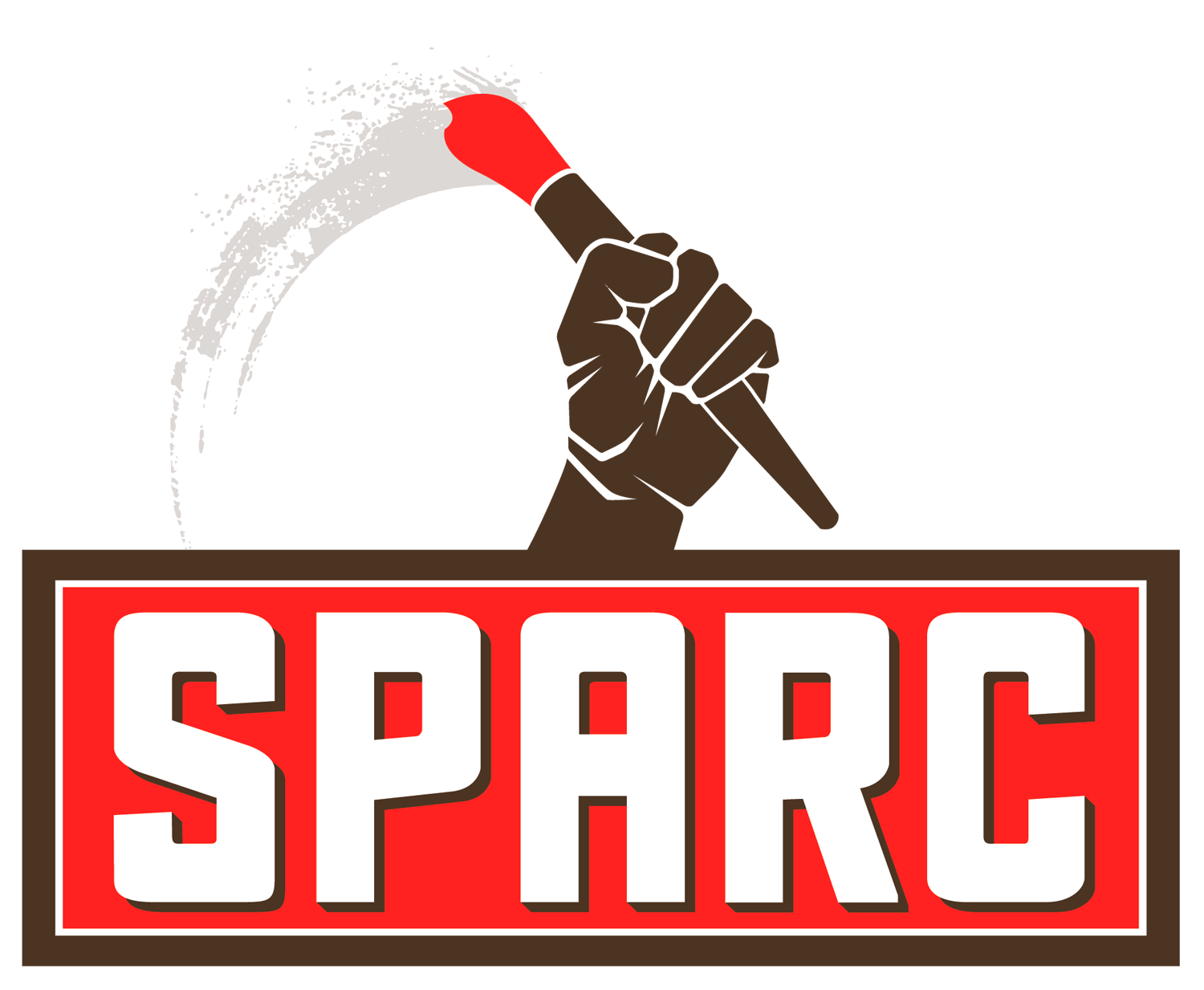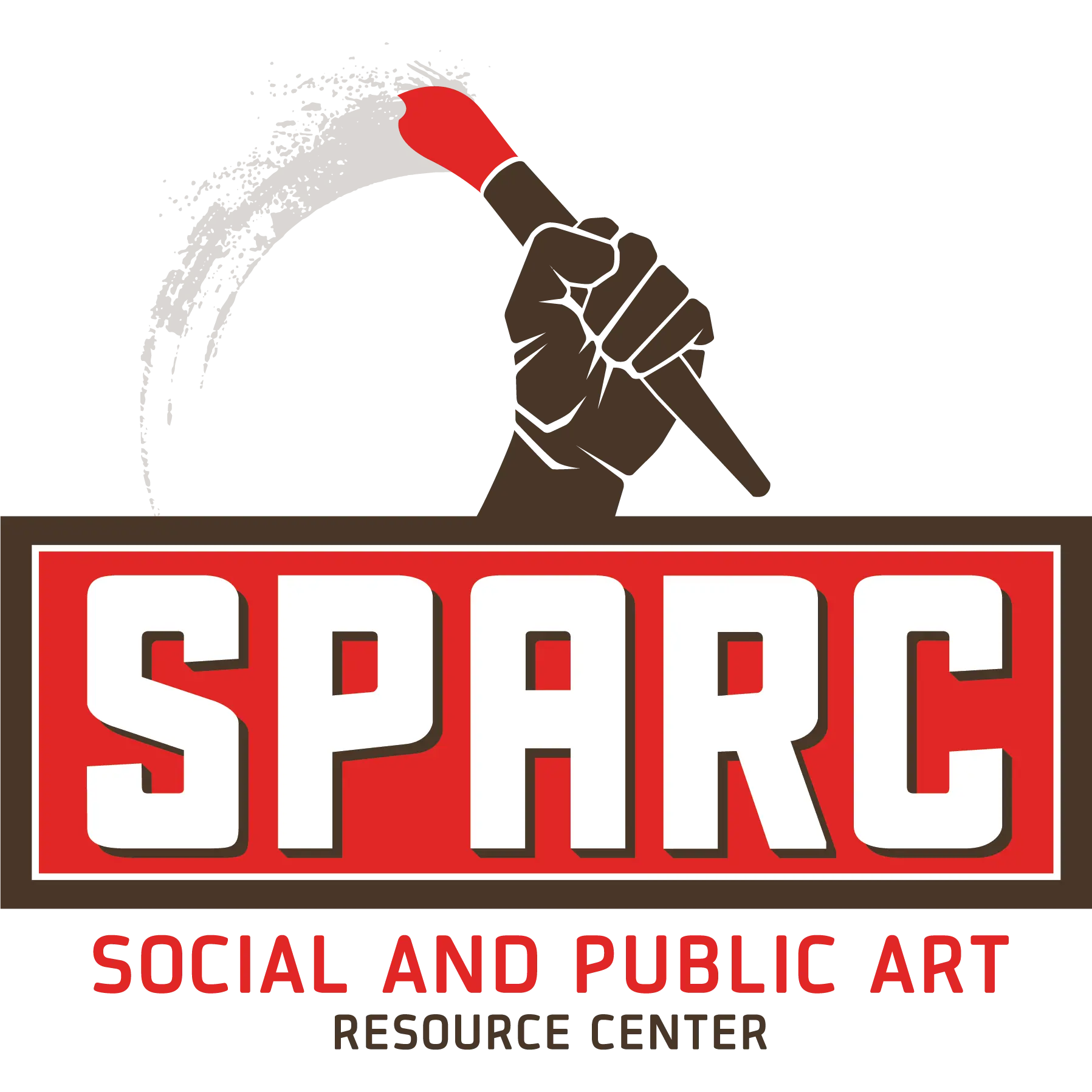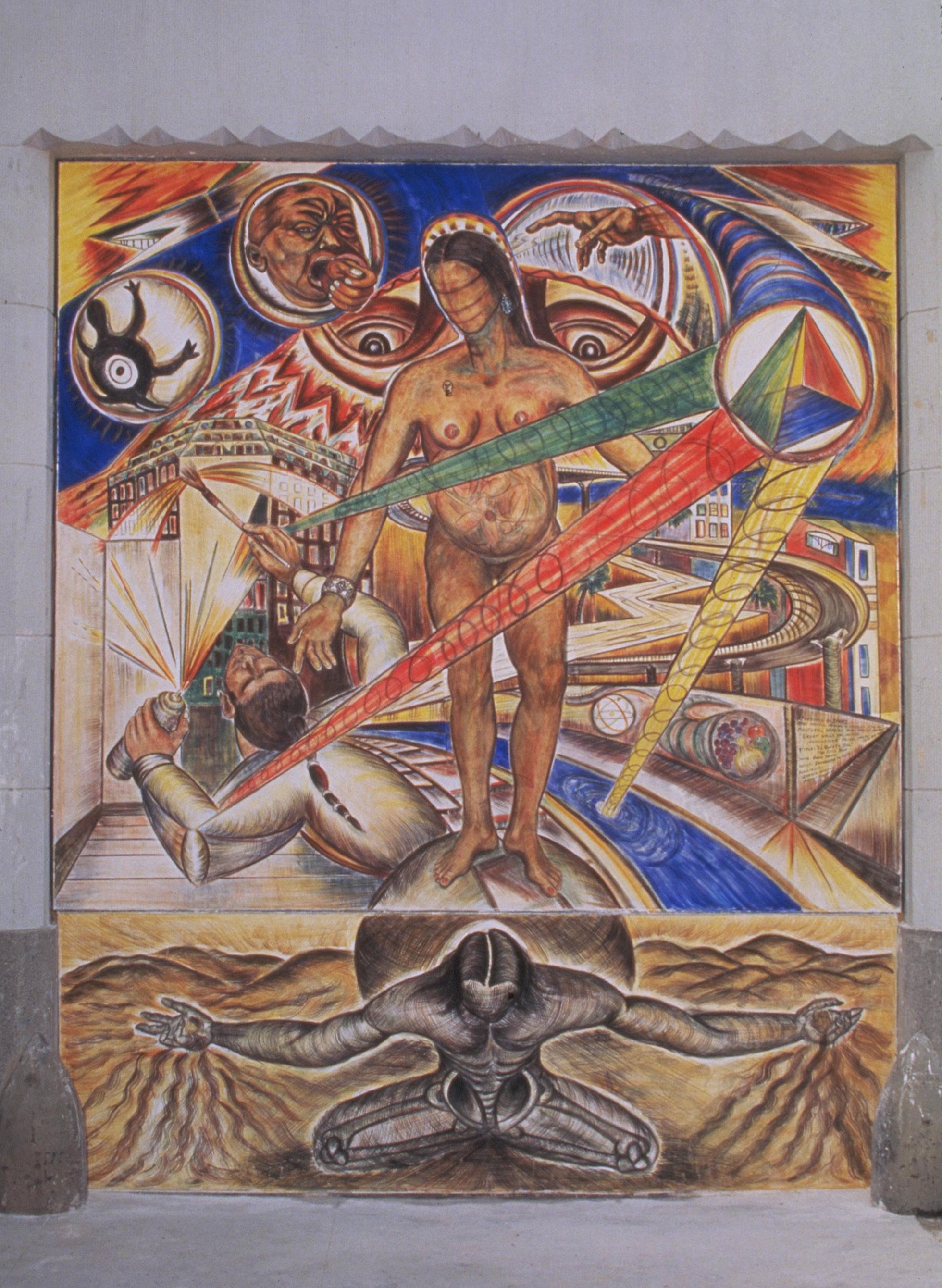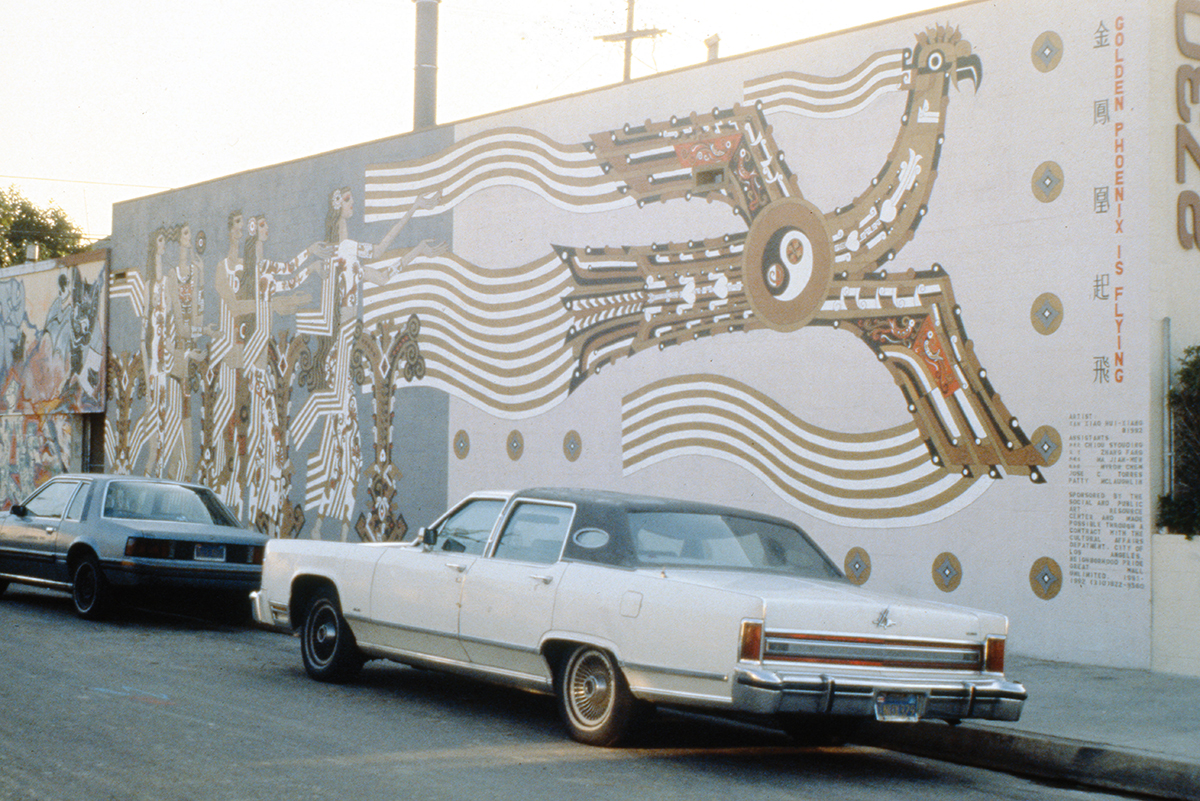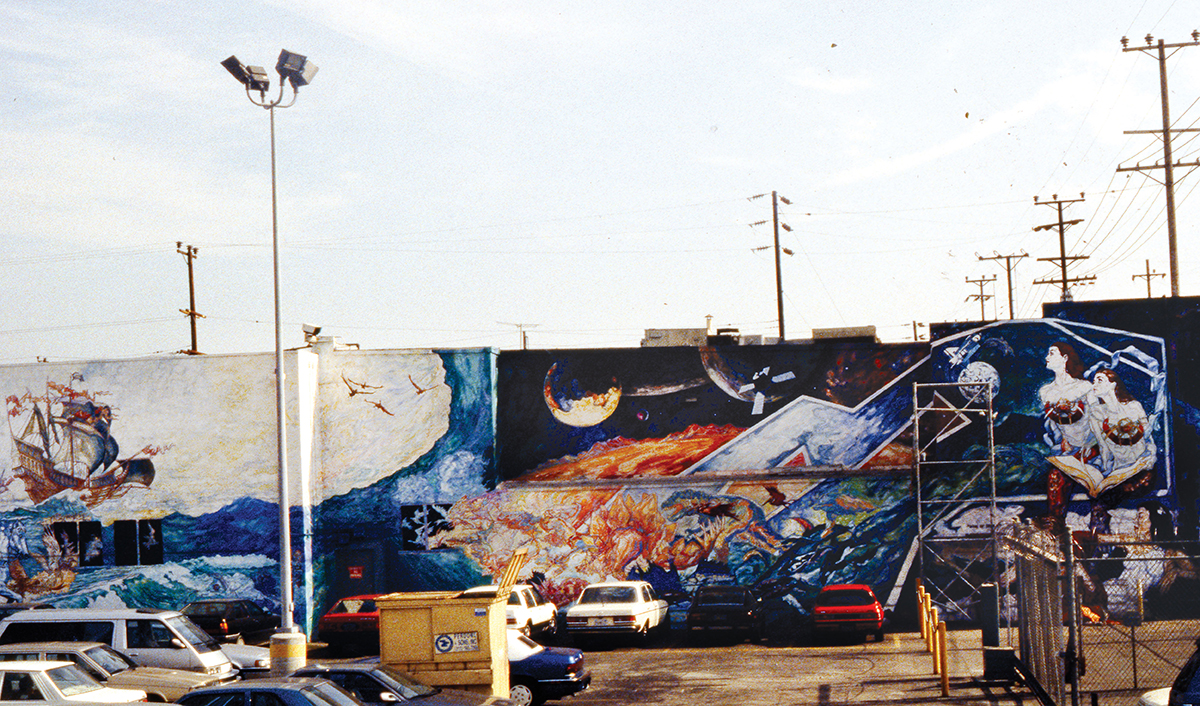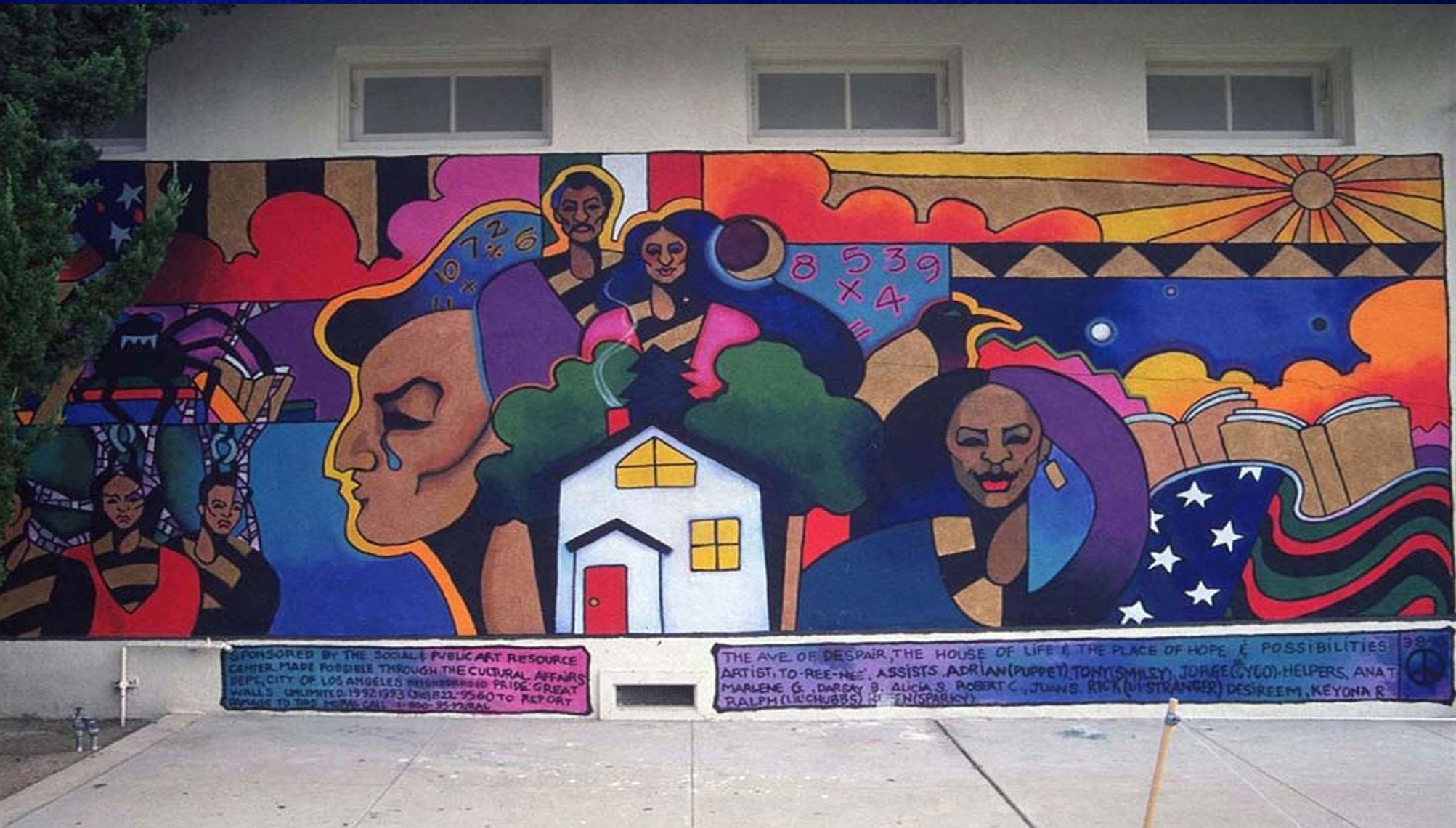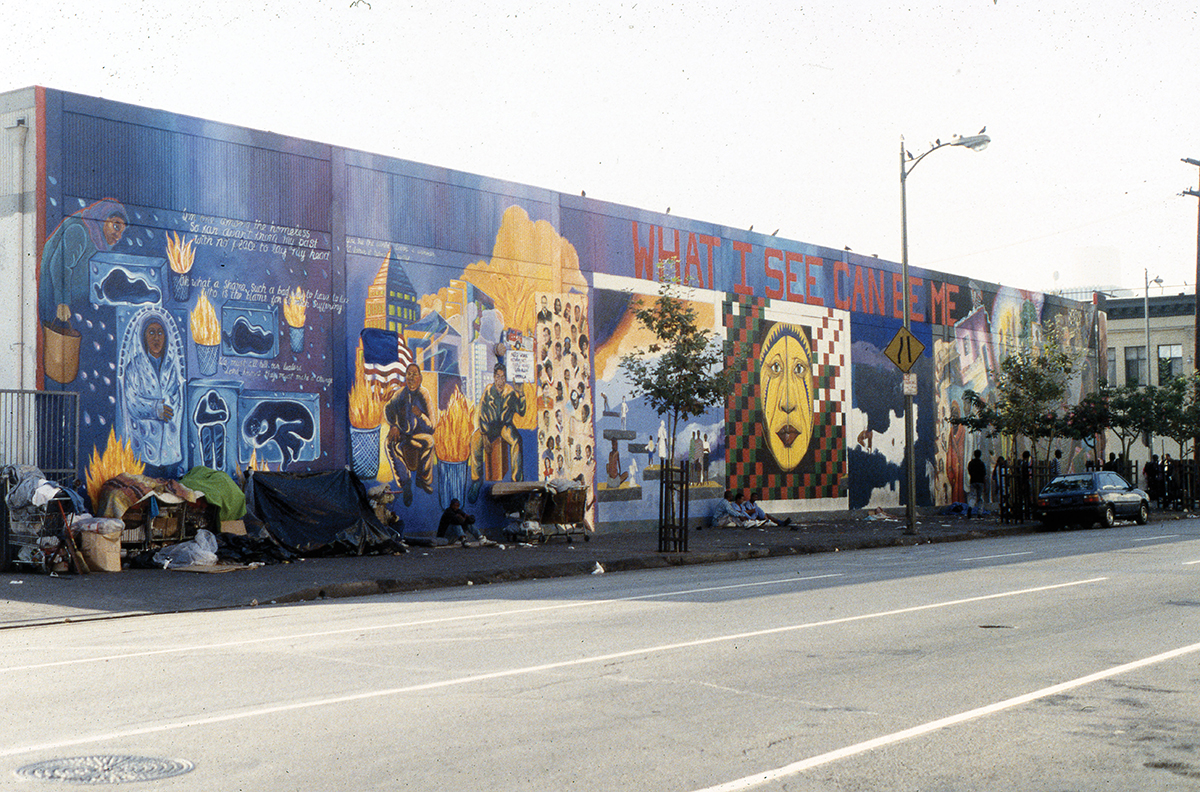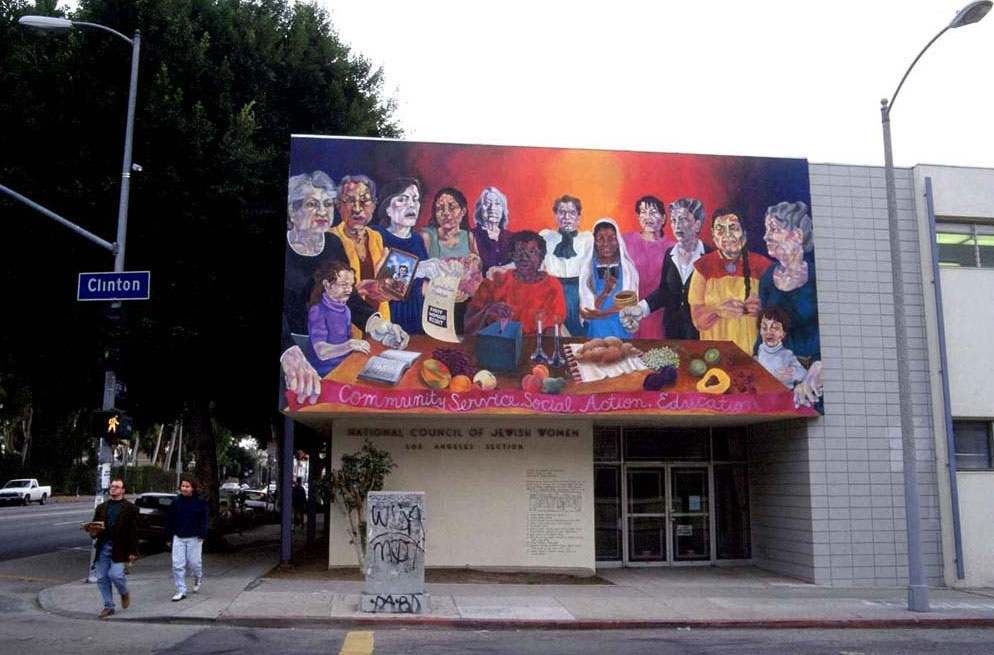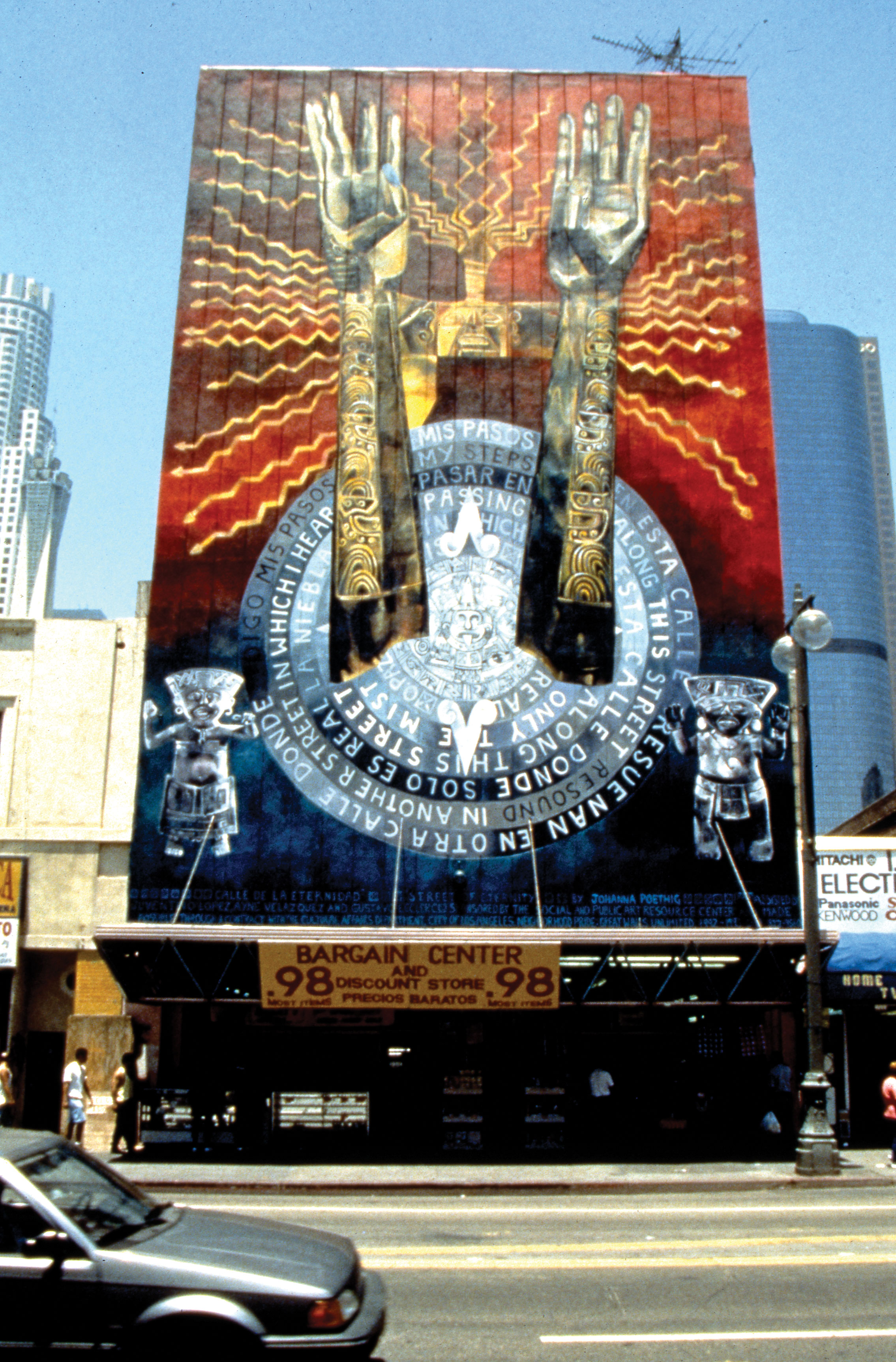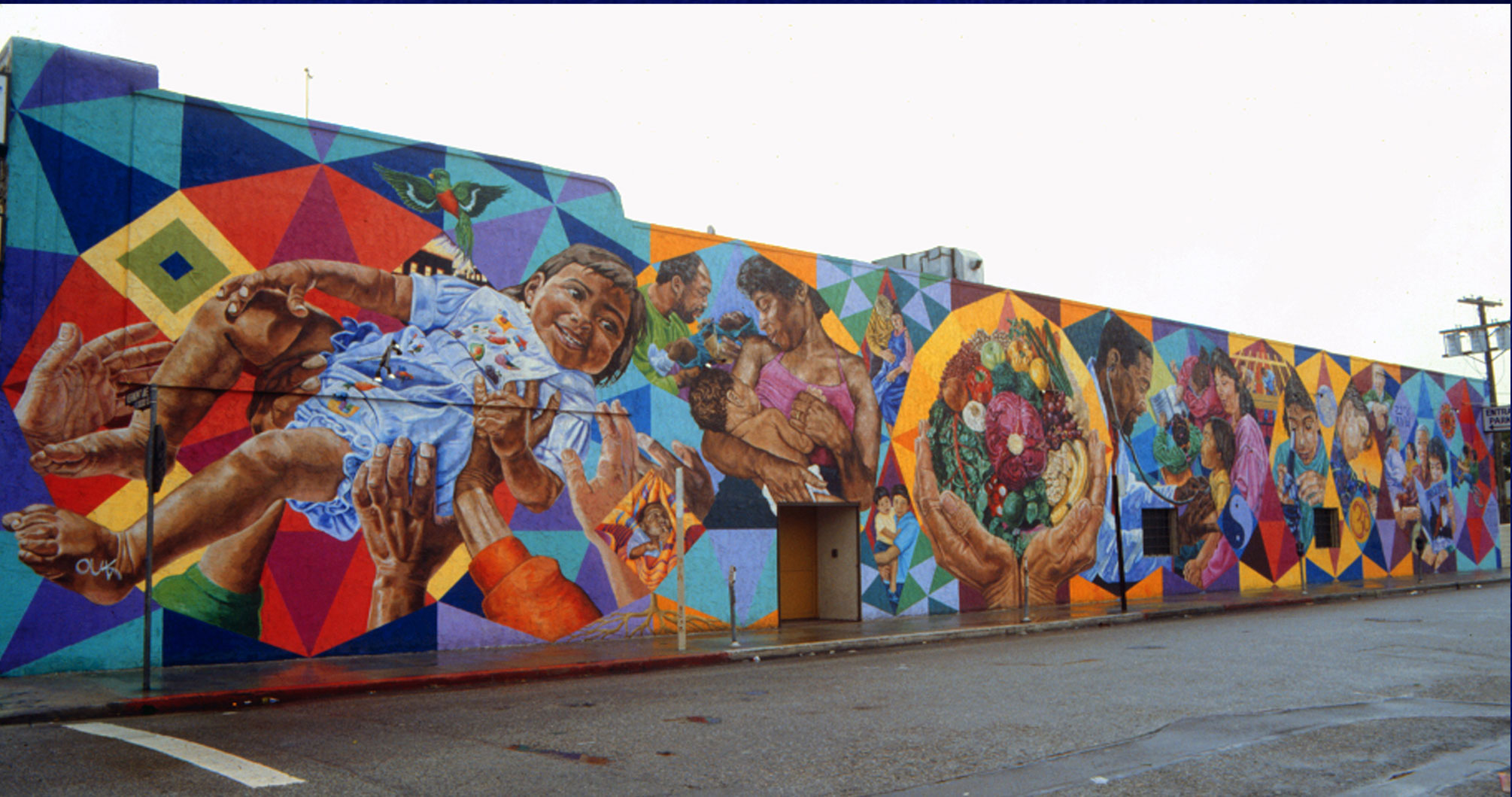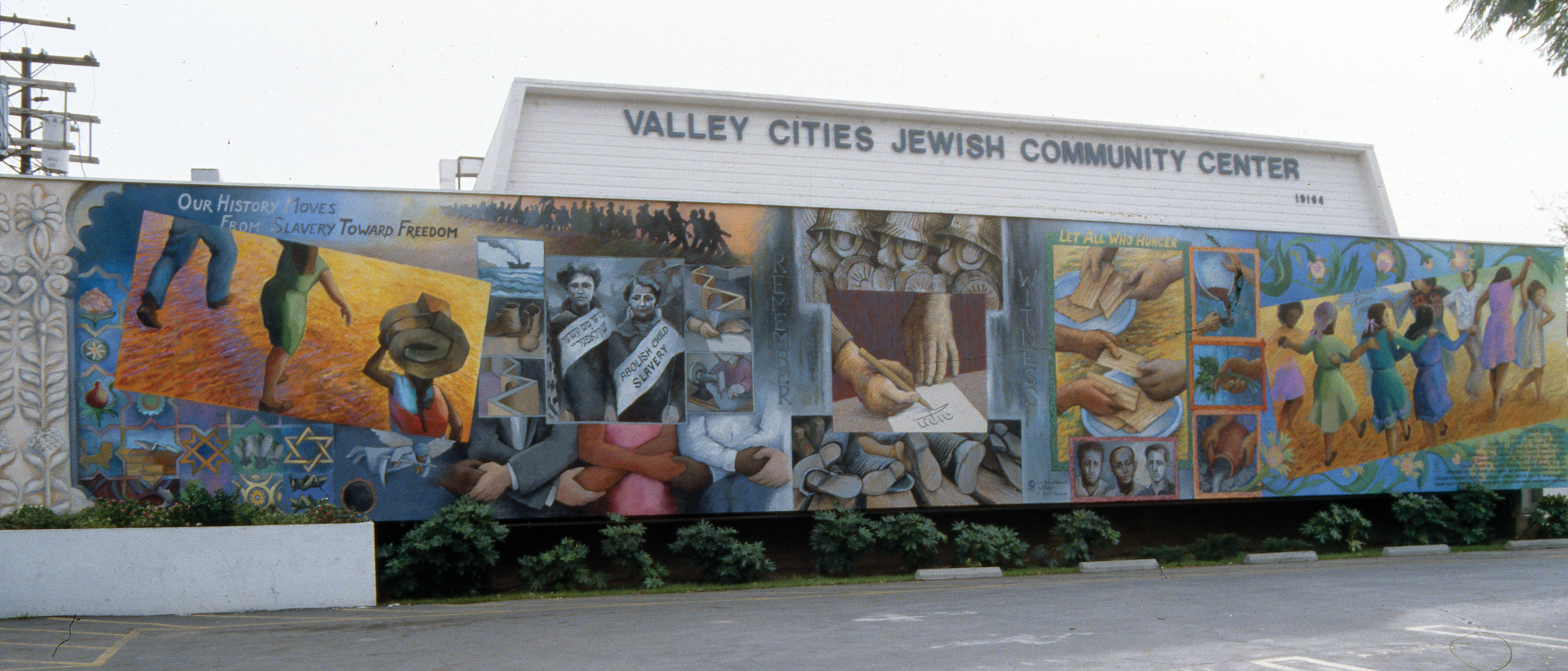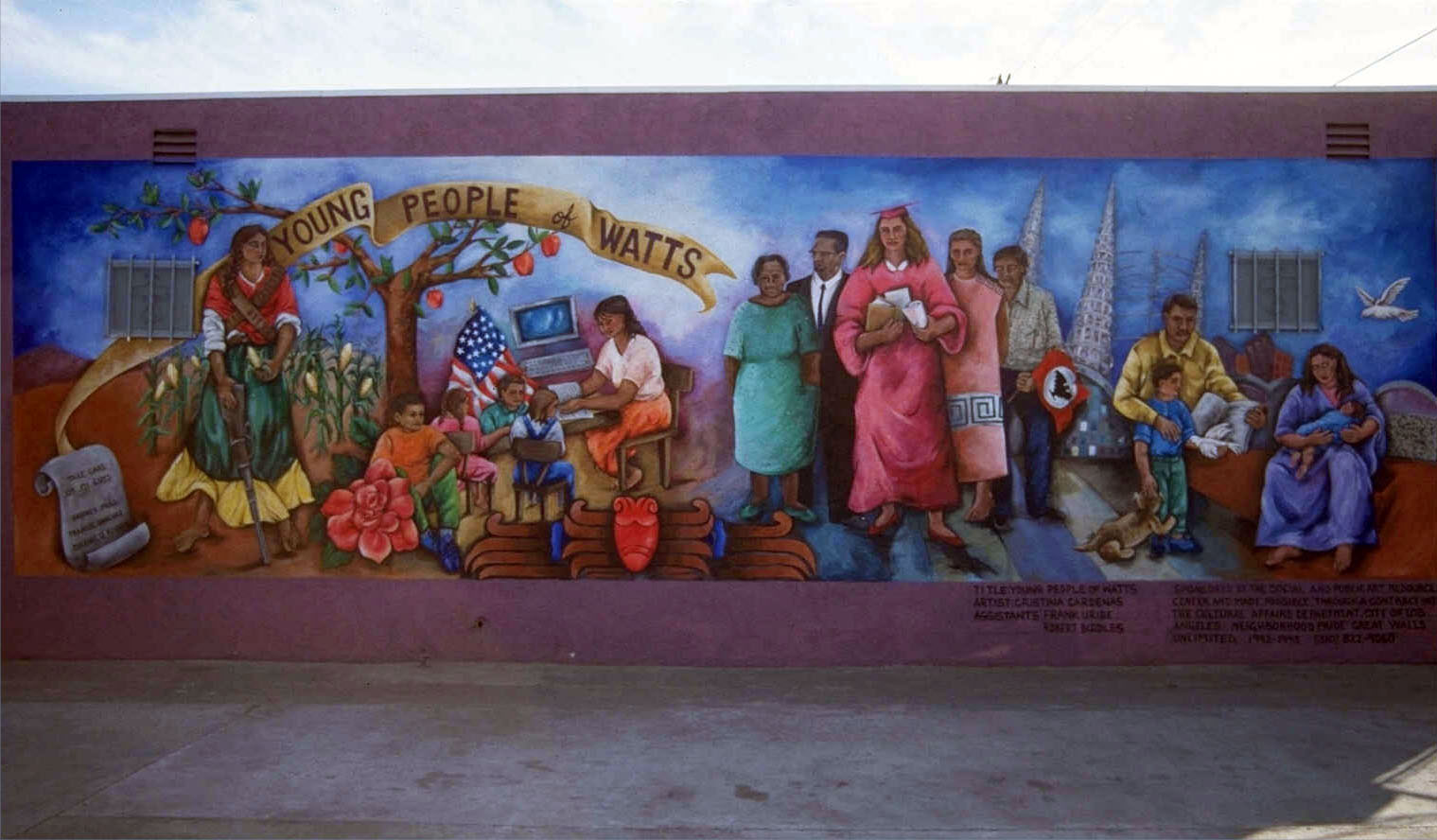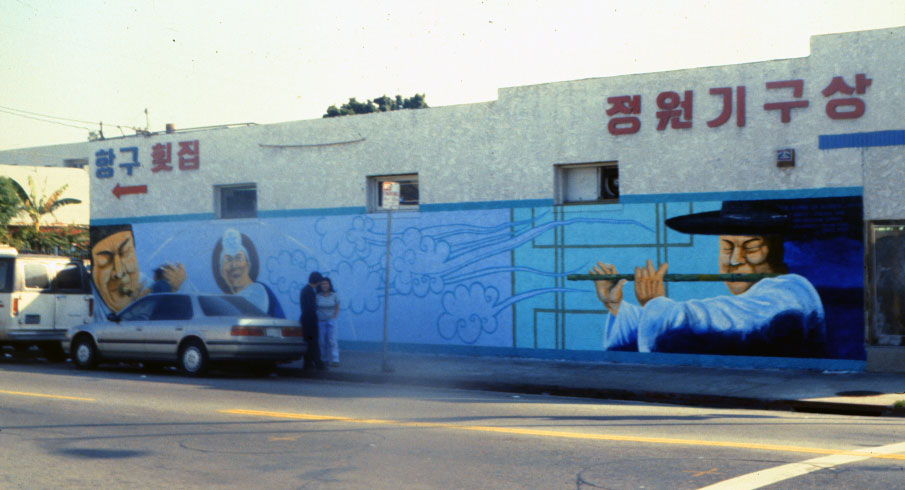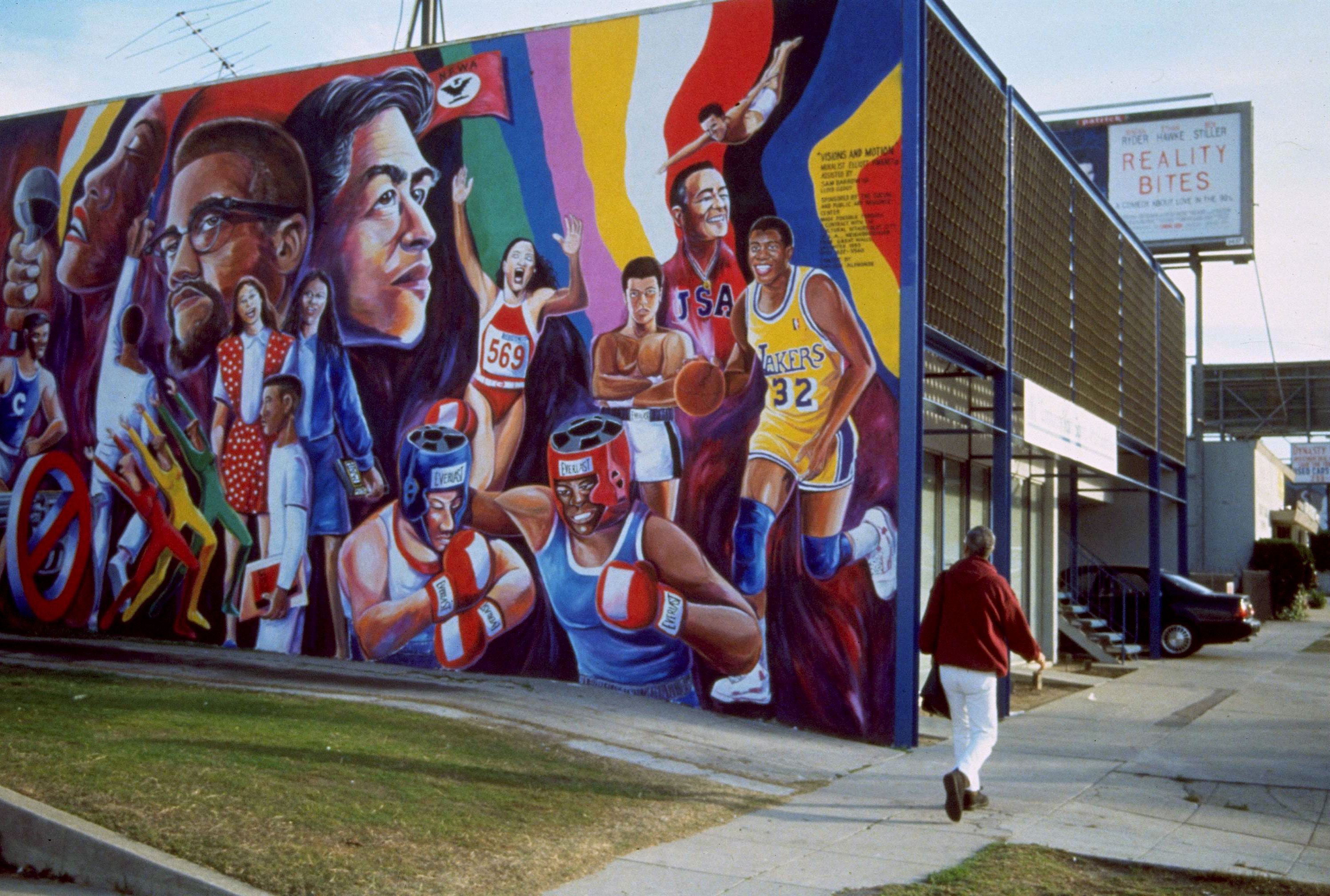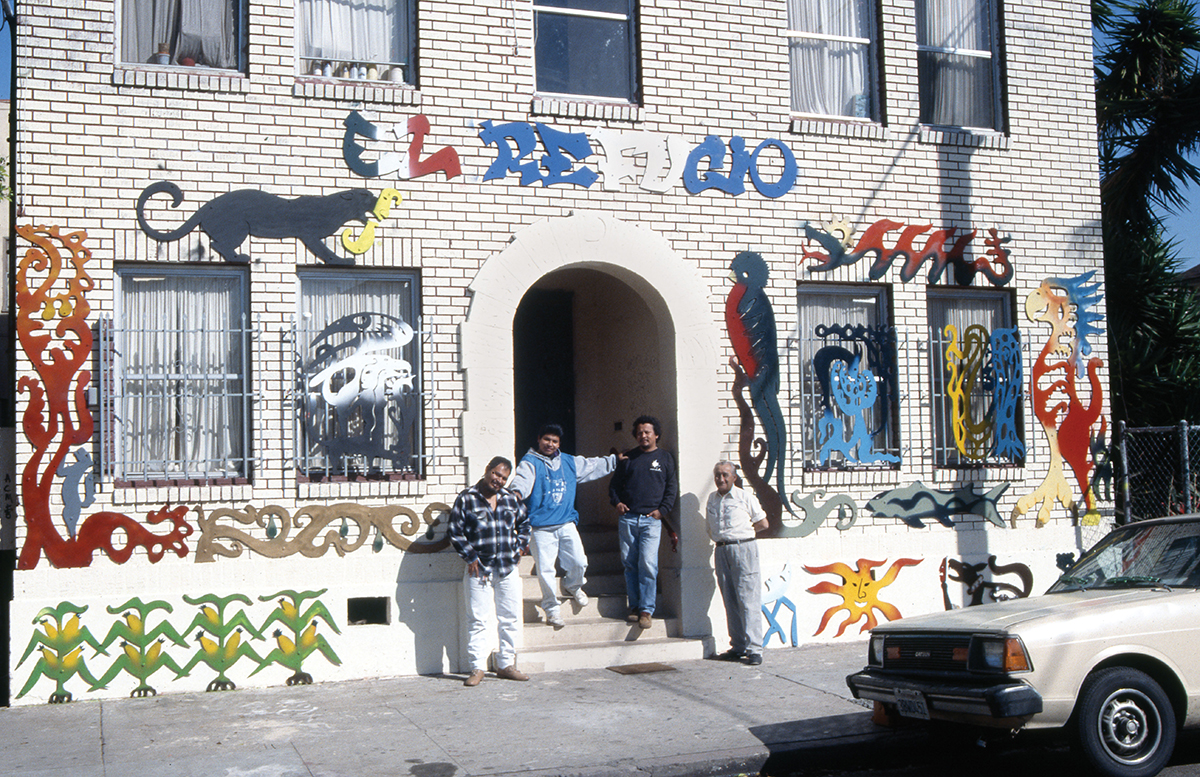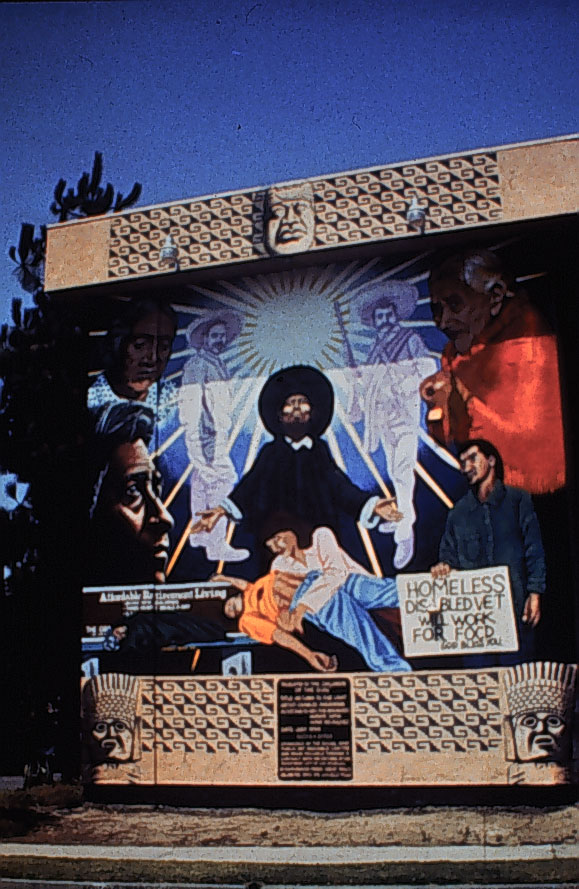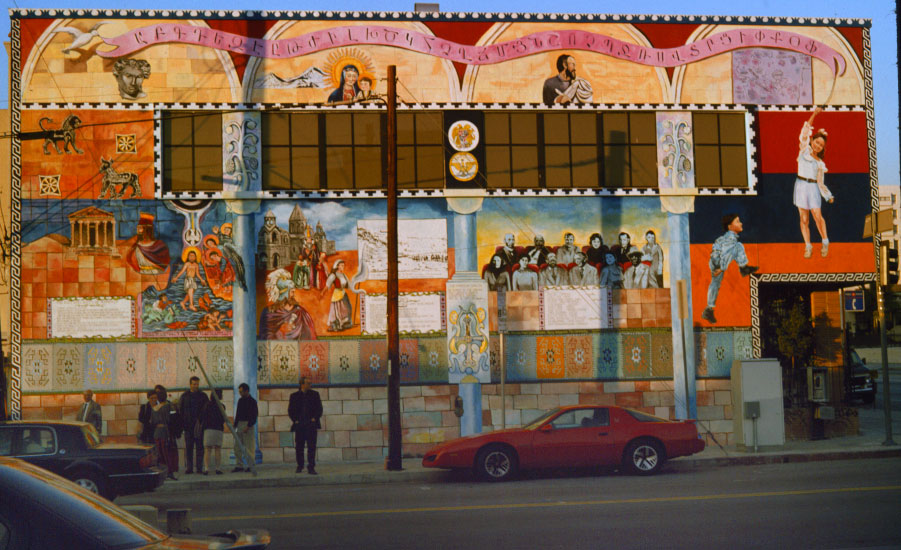Neighborhood Pride
El Quinto Sol (1992) by Federico Virgil
| Location | SPARC, 685 Venice Blvd., Venice, CA 90291 |
| Artist | Internationally-acclaimed Santa Fe artist Federico Vigil uses fresco painting to keep traditional Hispanic Cultural Values alive. His work at the New Mexico Museum of Fine Arts–in Santa Fe–commemorates the Cuarto Centenario of Spanish settlement in New Mexico. Vigil also has frescos at The Albuquerque Museum, The College of Santa Fe and other institutions. |
| Subject | This is a fresco, created by painting on wet lime plaster. At the center is a woman, pregnant with the future, surrounded by references to the history of mural painting. included are pictographs, images from Mexican muralists (David Alfaro Siqueros and Jose Clemente Orozco), and a fragment of Michelangelo’s “Creation of Man” form the Sistine Chapel ceiling. The title comes form the Pre-columbian conception of time (we are currently living through the “5th sun,” or the or the fifth cyclical epoch of creation. Virgil and his assistants also created a collaborative fresco at this site called “City of Angels.” |
| Status | The mural has faded and suffered de-lamination and efflorescence. |
Golden Phoenix is Rising (1989) by Hui-Xiang Xao
| Location | Noodle Factory, 622 Alpine Heights, Lincoln Heights, Los Angeles |
| Artist | Hui-Xiang Xao |
| Subject | |
| Status | The building was completely renovated and the mural was destroyed. |
Book of Dreams (1992) by George Yepes
| Location | Department of Children’s Social Services, 564 Mateo St, Los Angeles, CA 90013 |
| Artist | George Yepes was born in 1955 and raised in East Los Angeles. He earned a degree in business administration at CSU Los Angeles while taking painting classes at East Los Angeles College at night. Between 1979 and 1985 he was one of the East Los Angeles Streetscapers. He founded Academia de Arte Yepes, in 1992, the frist free mural art school in Los Angeles. His murals can be sene throughout Southern California, a series of which were made for NASA. In describing his artwork, Yepes states, “My themes are interpretations and visions of life, death, lust, sex decadence, pride, and the multitude of nuances webbed between them-my work is a celebration, observance, and mourning of a cynical life, each piece serving as a catharsis imploring me to become increasingly poignant in my interpretations.” |
| Subject | “A stream of sea creatures, birds, dinosaurs, spacecraft, and an oasis of color relieve the sterility of the building façade, transforming the building into a dreamlike fantasy.” – George Yepes Located at the LA County Children’s Services 24-Hour Child Abuse Center, the mural illustrates a world that is filled with adventure, from the high seas to outer space with various fantasy characters from animals, mythical creatures, space and sea ships, and a large sleeping angel at the entrance of the building. On either side of the mural children look into heir fantasy, one with an open book on her lap, the source of inspiration for their imagination. It was designed to comfort the troubled youth who come to the center in hopes of making their futures seem somewhat brighter. |
| Status | The mural had been painted by an advertisement–depicting a school of fish–for the seafood company that now inhabits the building. |
The Avenue of Despair. The House of the Life. The Place of Hope and Possibilities. (1992) by To’ Re’ Nee’ Keiser
| Location | Keiser Pacoima Elementary School, 11016 Norris Ave, Pacoima, CA 91331 |
| Artist | Keiser studied painting and illustration at Philadelphia College of Art (1979-81), A resident of Tuscson, Arizona, she has done more than a half-dozen public and private murals in that city since 1993. She is also an actor, dancer, singer and performance artist. |
| Subject | The mural is an argument for the role that education (represented by books and numbers) and a encourages a vision that moves from a tragic history into a future filled with hope and possibility. In a progression from left to right, the imagery of To’ Ree’ Nee’ Keiser’s mural shows how lives of danger and distress can be turned around to a sunny future in he protective embrace of a loving home life. The concept clearly emerges in a fully developed presentation that positions education, family, and community as equal partners. The first section, House of Death explores the ramifications of the failure mentality and hopelessness so prevalent in he urban psyche. Chained to a vision of despair and tangles in the web of dysfunction, the minds of youth starve. In this section the flag as it is flown backwards signals distress and calls our attention to the tragedy of the unrealized American Dream. A central female figure sheds a tear for the plight of our youth. Finally, the piece embraces a visual flow and clarity in that which is positive, like education, home, and family. |
| Status | This mural has been completely whitewashed. |
What I See Can Be Me (1993) by Michael Schnorr and Yreina Cervantez
| Location | 5th Street between Towne Avenue and Crocker Street, Skid Row, Los Angeles, CA |
| Artist | Michael Schnorr is one of the founding members of the San Diego-based Border Arts Workshop/Taller de Arte Fronterizo (BAW/TAF), a binational group of artists and activists interested in addressing ” the social tensions that the Mexican-American Border creates, while asking us to imagine a world in which this international boundary had been erased.” Los Angeles based artist Yreina Cervantez is a second generation Chicana born in Garden City and raised in Southern California. She received her MFA in 1989 and is currently a professor at CSU Northridge. |
| Subject | Schnorr and Cervantez designed the panels closest to Crocker St. with major input from the transients of Skid Row. Cervantez’s panel “A Rain Drop Falls on My Lips” shows a woman walking alone through a landscape of trashcan fires and huddled bodies. An additional panel is dedicated to homeless veterans. The painters were assisted by artists from the homeless community: Florence Hawkins, Eric Kelly and Charles E. Snow. |
| Status | The mural has suffered delamination, efflorescence, and heavy graffiti damage; a community restoration is planned. |
Breaking Bread / Not Somewhere Else, But Here (1993) by Daryl E. Wells
| Location | National Council of Jewish Women, 543 N Fairfax Ave, Los Angeles, CA 90036 |
| Artist | Born and raised in Los Angeles, Wells attended The Rhode Island School of Design and The Slade School of Art in London. |
| Subject | The mural depicts from left to right Betty Friedan (author and activist), Barbara Boxer (senator), Hannnah Senesh (poet and holocaust rescue mission fighter), Dolores Huerta (United Farm Workers President), Lee Krasner (artist), Barbara Jordan (congresswoman ad civil rights worker), Emma Goldman (anarchist and labor rights activist), Lillian Hellman (playwright), Rigoberta Menchu (Guatemalan human rights activist and Nobel Peace Prize Winner) and Hannah Solomon (founder, National Council of Jewish Women). Written under the portraits are the words: Community Service, Social Action, Education. |
| Status | The mural is in good condition; a varnish has been added. |
Calle de la Eternidad (1993) by Johanna Poethig
| Location | BBF Broadway Building, 351 S Broadway, Los Angeles, CA 90013 |
| Artist | Johanna Poethig was raised in the Philippines through high school and has lived in Chicago, san Francisco and Oakland since coming to the United States. she received her BFA at the UC Santa Cruz and her MFA at Mills College (in Oakland, CA). Poethig’s public art works intervene in the urban landscape, in neighborhoods, on freeways, in parks, hospitals, schools, homeless shelters, cultural centers, advertising venues and public buildings. |
| Subject | “The architecture of the building really affected me because it’s so high off the ground and so much of the background is all those buildings reaching to the sky. Also, the whole context of being in Broadway, in a very Latino neighborhood, is so important to me. I started to look for symbols and artifacts from pre-Columbian America. The arms that are reaching to sky based on Peruvian gold work. The Aztec Calendar contains text by Octavio Paz about time and place. It’s trying to bring poetry to the idea of being at home and in exile at the same time. In the middle of a commercial LA landscape you have something that is talking about connecting us culturally and historically to our past and present.”-Johanna Poethig |
| Status | The building that the mural was on was demolished for extensive renovations However the SPARC Mural Rescue Program preserved a digital rendering of the mural. The digital file is currently in the SPARC archives, awaiting a suitable wall to re-inhabit. |
Lifeline: Creating A Healthy Community (1993) by David Fitcher
| Location | Practicare Medical Group, 3031 S Vermont Ave, Los Angeles, CA 90007 |
| Artist | David Fichter has been creating community murals for over 25 years, working all over the United States and in other countries, including Armenia, Georgia and Nicaragua. |
| Subject | Fichter painted this mural with the help of Los Angeles youth. It illustrates the metaphor of community as a quilt, many parts coming together as one to shelter and raise a child. The various necessities for this universal child are interwoven, from a balanced diet and parental love to health care and education. The message of the mural is that the wellbeing of a community is in direct correlation to the well being of each child in the community and vice versa, emphasizing the need for collective harmony. |
| Status | This mural has been completely destroyed (building renovation)–after a restoration in 1998. |
Toward Freedom (1992) by John Pitman Weber
| Location | Valley Cities Jewish Community Center, 13164 Burbank Blvd, Sherman Oaks, CA 91401 |
| Artist | Born in 1942, the crucial and formative decades of the 1960s and 1970s provided the themes and the messianism for Weber. Interest in liberation theology occurred some four years after his 1966 arrival in Chicago, and corresponded to lifelong held moral and ethical values derived from his family, and his own intellectual probing in anthropology, philosophy, and linguistics. In the seventies Weber was a leader in the Chicago street mural movement. He received his M.F.A at the Art Institute of Chicago, and his B.A. in history and literature at Harvard University in Cambridge, MA where he graduated cum laude. John Weber accepted Fulbright and French government fellowships to stud the history of the French revolution at the Sorbonne in Paris. |
| Subject | The design is based on the themes of Exodus, Passover and Seder in a universal theme intersecting with other cultural groups. Exile, liberation and celebration are repeated as shared experiences. In particular, showing concern for shared struggles important to the Jewish experience in the U.S., the mural includes references to the trade union struggle for labor emancipation and to the civil rights struggle asking for full citizenship rights for all. War and repression are also included but avoid any direct reference to the Holocaust; instead they evoke the on-going, shared experience of violent repression, which is a continuing reality in many parts of the world. The main image on the left, based on photos of Central American and African refugees, evokes the departure from Egypt and all subsequent flights into exile/safety/freedom. Its tilt brings the viewer into the mural and emphasizes the uphill struggle of the emigrants. |
| Status | This mural has been completely whitewashed. |
Young People of Watts (1993) by Christina Cardenas
| Location | Young People of Watts Improvement Center, 10712 Wilmington Ave, Los Angeles, CA 90002 |
| Artist | Christina Cardenas |
| Subject | |
| Status | This mural and building completely were completely destroyed; site under construction. |
The Sound of Korea (1993) by Kuk Chul Han
| Location | 1100 S Western Ave, Los Angeles, CA 90006 |
| Artist | Kuk Chul Han |
| Subject | |
| Status | This mural was destroyed in a complete building renovation. |
Visions and Motions (1993) by Elliot Pinkney
| Location | Community Youth Sports and Arts Foundation, 4830 Crenshaw Blvd, Los Angeles, CA 90043 |
| Artist | Elliot Pinkney |
| Subject | |
| Status | This mural has faded, delaminated and has its lower right quadrant covered in tagging. |
Untitled (1993) by Michael Amescua
| Location | El Rescate/ El Refugio, 1565 24th Street Los Angeles |
| Artist | Amescua graduated in 1975 with a B.A. in Anthropology fro Occidental College. He has completed public art installations for the City of Gardena and Santa Fe Springs, The Chatsworth Courthouse, The California Highway Patrol, The Los Angeles Department of Water and Power, The Los Angeles International Airport, Paseo Colorado in Pasadena, and the Montebello Transit Center. His smaller pieces are in the collections of The Los Angeles County Museum of Art, the UCLA Museum of Cultural History, and The Brandiwine in Pennsylvania. |
| Subject | Amescua and his team restored and decorated the façade of El Reascate/ El Refugio, a refuge for Central American immigrants during times of conflict in their native lands. This mural is the first of its kind for SPARC. It is made up of cutout steel figures that are mounted onto the outside walls of the mural site. Images of the mural include maize plants and several other Mesoamerican symbols with the words, “El Refugio” at the center done in modern “tagging” calligraphy. |
| Status | This piece was destroyed when the building was demolished. |
Return of the Light (1993) by Charles Freeman
| Location | Carlota Park Apartments, 227 E Ave 41, Los Angeles, CA 90031 |
| Artist | Born and raised in Houston, Texas, Freeman is a self-taught artist. He moved to Los Angeles in 1974 while active in the Black Panther Party as an organizer. For the past 13 years he has operated his own sign-painting business in Walnut, California, near his Pomona home. |
| Subject | The mural depicts to prevalent social ills: the senseless killing of young people and homelessness. The shaman in the center represents a healthy state of wholeness. Cesar Chavez represents vision being focused. The elderly are symbols of rich experience and wisdom. The spirits of Pancho Villa and Zapata are there to signify strength and courage. The mural’s title refers to the role of the spiritual in finding solutions. |
| Status | This mural has suffered from delamination. |
Survival of a Nation (1993) by Alysse Stepanian
| Location | Armenian Cultural Center, 1025 N Vermont Ave, Los Angeles, CA 90029 |
| Artist | Stepanian is a multimedia artist and the creator of the Manipulated Image Video Screenings. She studied with Rachel Rosenthal and has collaborated with Philip Mantione under the name “Box 1035.” |
| Subject | The title of the mural refers to the cultural timeline of Armenia. Images chronicling the history of the region, from Eastern Orthodox Icons and Bronze Sculptures to a panel of important Armenians. The imagery leads into a hopeful future in which two children play, one holds a ribbon with the Armenian Alphabet. |
| Status | This mural has been completely whitewashed. |
